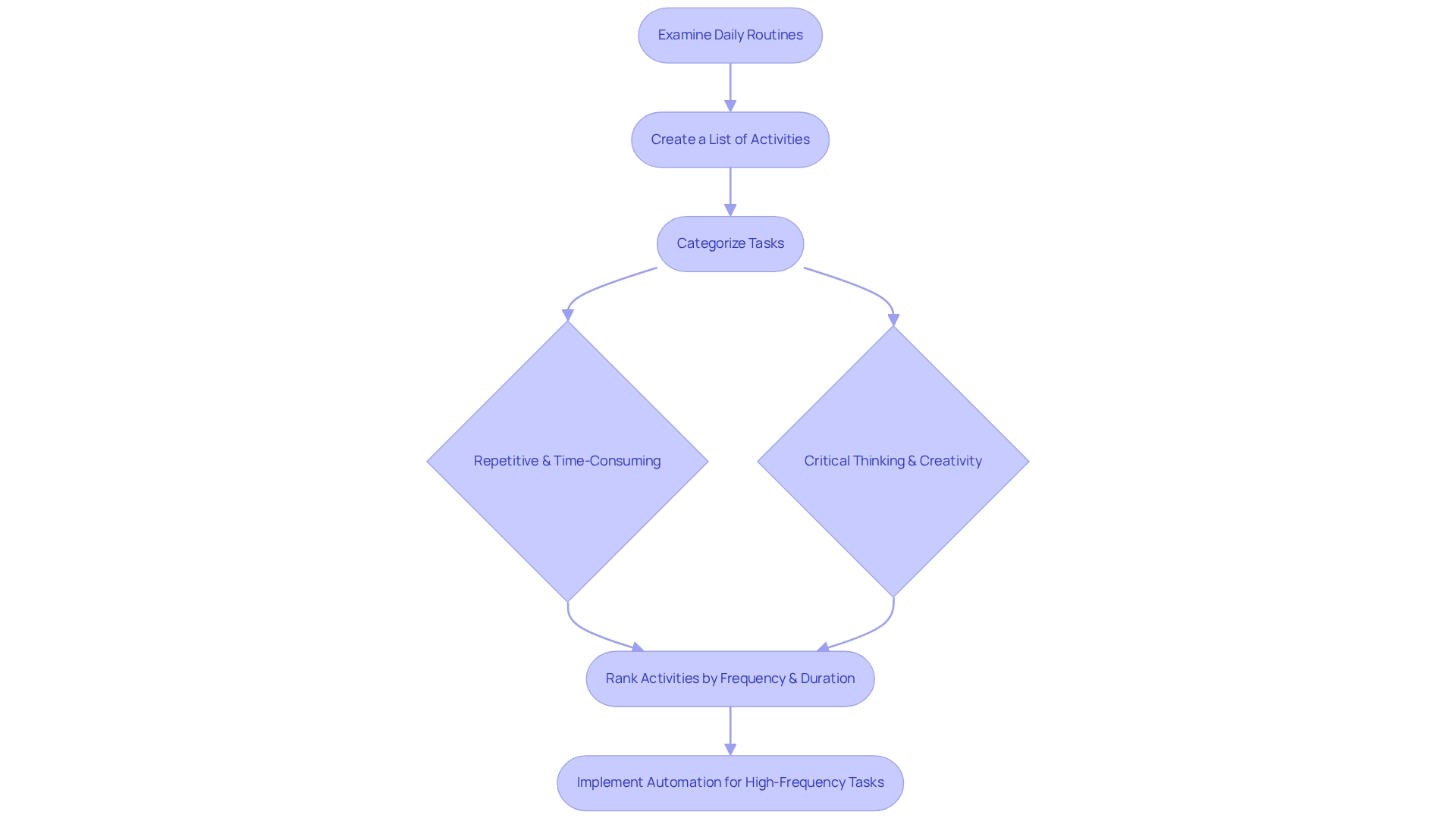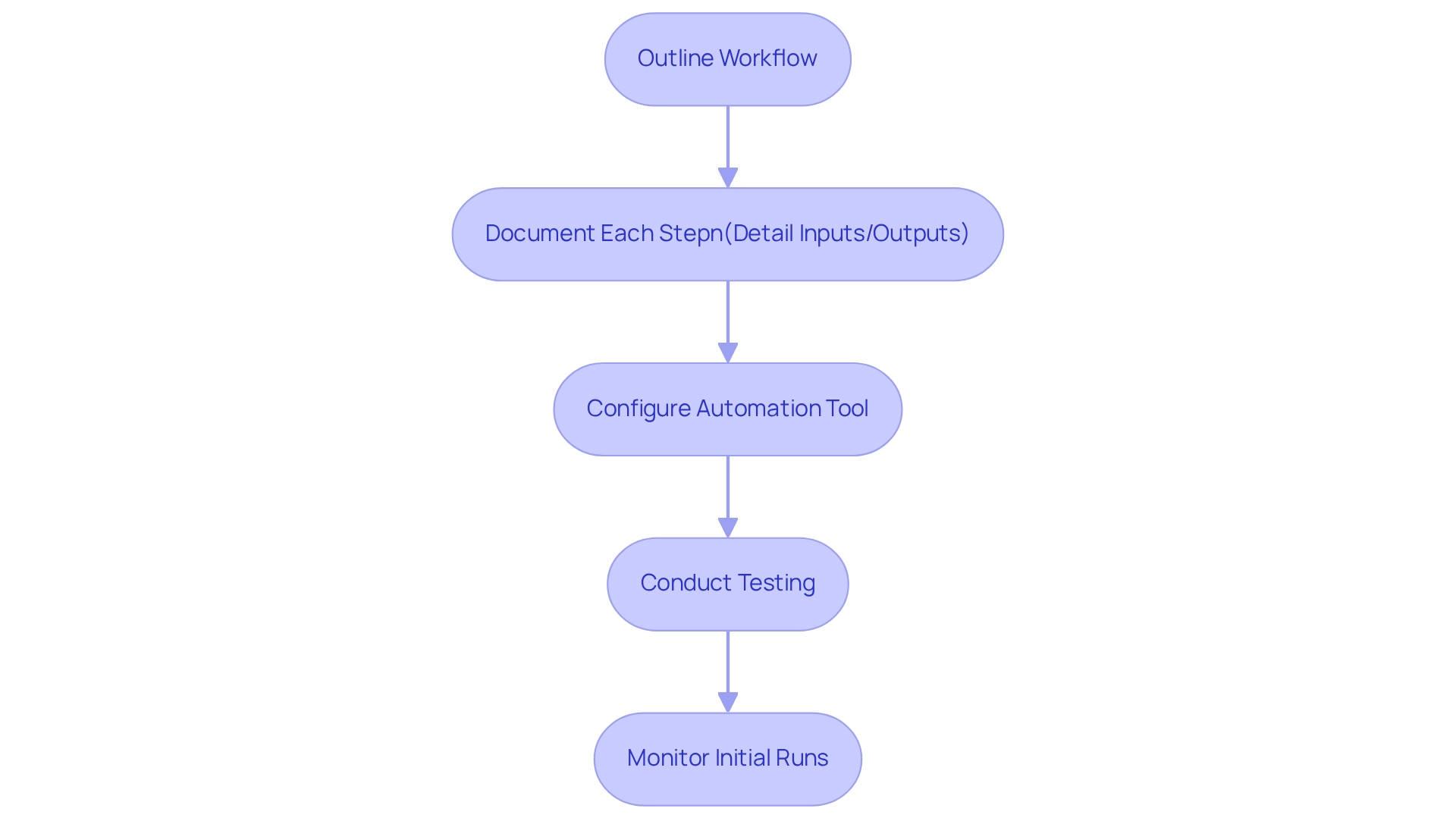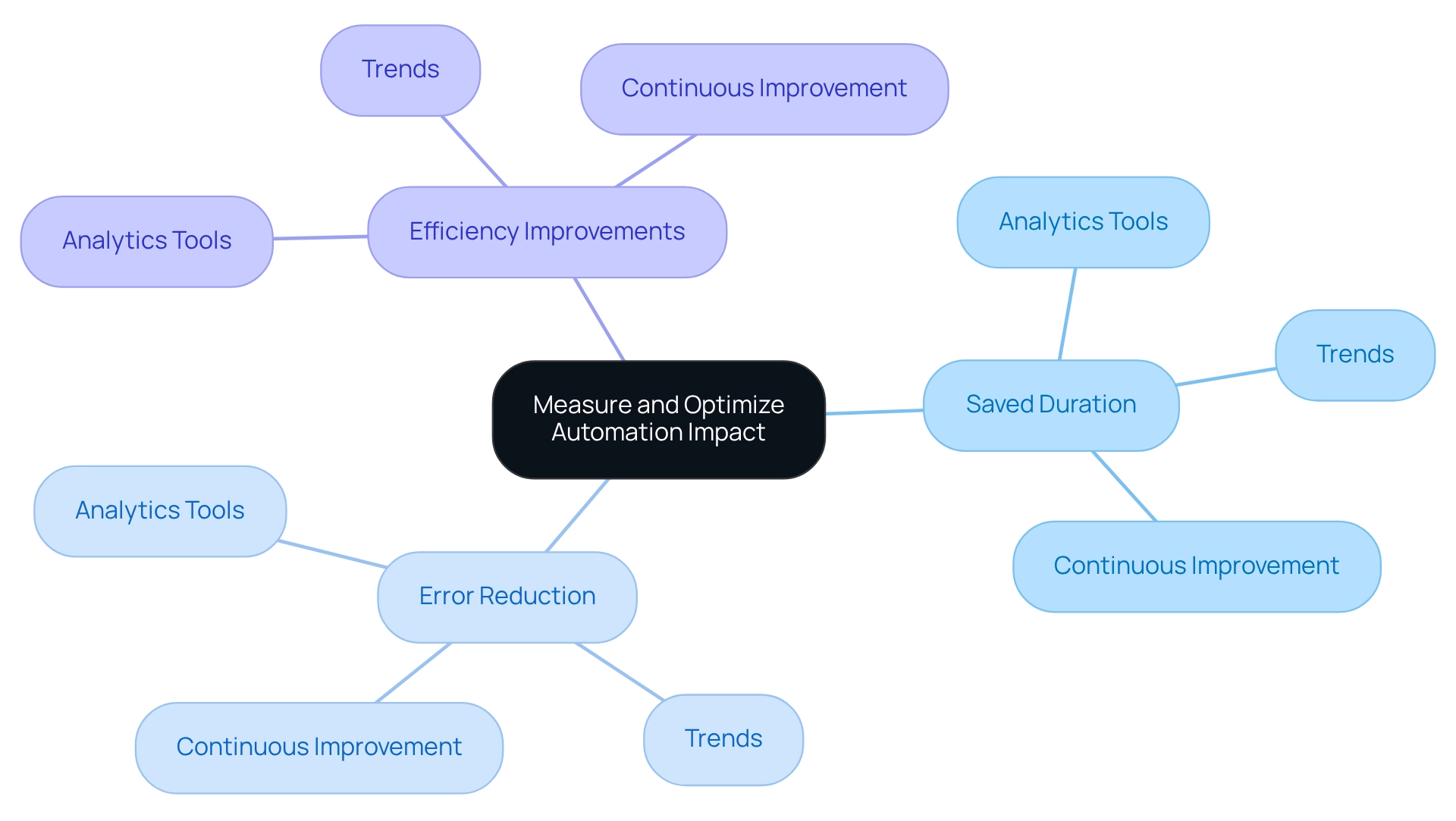Overview
The article outlines five essential steps to master repetitive task automation, crucial for enhancing efficiency in various workflows. By identifying tasks suitable for automation, selecting the right tools, setting up processes, and measuring their impact, organizations can significantly streamline operations. This approach not only improves productivity but is also evidenced by the reported 18% performance improvement in companies that embrace such automation strategies.
Introduction
In the modern workplace, repetitive tasks can consume valuable time and resources, hindering productivity and innovation. As organizations strive to optimize their operations, the adoption of task automation emerges as a transformative solution. By harnessing technology to handle mundane activities, businesses can redirect their focus toward strategic initiatives that drive growth.
But how can organizations identify which tasks to automate? What tools are best suited for this purpose? This article delves into the essentials of repetitive task automation, exploring how to:
- Identify suitable tasks
- Select the right tools
- Establish effective processes
- Measure the impact of automation
With insights into best practices and real-world examples, it offers a roadmap for organizations eager to enhance efficiency and embrace the future of work.
Understand Repetitive Task Automation
Repetitive task automation is a crucial aspect of modern technology, enabling individuals to shift their focus from mundane tasks to more strategic endeavors. By utilizing repetitive task automation for these activities, organizations can significantly reduce the effort required to complete them, leading to enhanced productivity and efficiency. Have you ever wondered how tools like Kodezi CLI can transform your workflow? Kodezi empowers teams to auto-heal codebases in seconds, ensuring that time spent on pull requests is minimized. In fact, organizations that embrace automation report an impressive 18% improvement in performance, highlighting the tangible benefits of such solutions.
Automation encompasses a wide range of activities, from simple data entry to intricate workflows involving multiple systems. Current trends indicate that businesses neglecting mechanization technologies risk losing essential efficiency and innovation. Understanding which tasks can be automated is the first step toward effectively integrating these processes into your work. For instance, the Knowledge Digital Experience case study illustrates how mechanization can enhance user engagement and operational efficiency.
Furthermore, it is vital to consider the impact of automation on the workforce, as at least 50% of employees express concerns regarding job security. By acknowledging these factors, organizations can navigate the landscape of repetitive task automation more effectively. Are you ready to explore how automation can revolutionize your coding practices? Delve into the tools available on the Kodezi platform to unlock new levels of productivity and code quality.
Identify Tasks for Automation
To effectively recognize activities for repetitive task automation, start with a thorough examination of your daily routines. Have you considered the tasks that consume your time? Create a comprehensive list of all activities you regularly engage in, categorizing them into two distinct groups: those that are repetitive and time-consuming versus those that require critical thinking or creativity. Focus on activities that are rule-based, high-volume, and prone to human error by implementing repetitive task automation. Typical instances include data input, report creation, and email replies.
After assembling your list, rank these activities according to their frequency and the duration they require. Repetitive task automation of high-frequency activities not only streamlines your workflow but also enhances your return on investment. Tools such as Kodezi CLI can significantly improve programming efficiency by swiftly AutoHealing codebases in seconds. This enables teams to concentrate on more essential tasks and avoid wasting effort on pull requests. By implementing repetitive task automation for activities that require considerable time and are performed frequently, you can greatly enhance efficiency and minimize the likelihood of mistakes in your daily operations. Furthermore, implementing optimal methods for selecting activities to automate will additionally improve your overall efficiency.

Choose the Right Automation Tools
In the fast-paced world of software development, selecting the right tools to streamline processes is crucial for maximizing efficiency. Developers often encounter challenges related to code quality and production issues. How can these be alleviated? Enter Kodezi CLI, a tool that stands out for its ability to simplify tasks across various applications and platforms. It enhances code quality independently, addressing issues before they reach production.
When evaluating automation tools, it's essential to consider your specific needs. What activities do you aim to automate? What systems are currently in use? Kodezi CLI excels in automated code debugging and optimization, significantly simplifying the setup process. Its capacity to swiftly identify and rectify codebase issues, along with its support for multiple programming languages and detailed explanations of errors, allows developers to focus on delivering code that aligns with the latest security best practices and coding standards.
Furthermore, support and community resources play a vital role in the user experience. Access to a robust support network can facilitate a smoother transition. Kodezi CLI not only provides repetitive task automation but also offers advanced features that enhance performance and security compliance, making it an attractive option for developers. As the demand for automation continues to rise—over 90% of organizations have reported increased needs across departments in the past two years—choosing the right tools becomes even more critical. Successful applications demonstrate tangible benefits; for instance, some have reduced feedback response times by as much as 80%. By carefully considering these factors, developers can select tools that not only address immediate requirements but also foster long-term growth and efficiency. Ready to see the difference? Consider trying a demo of Kodezi CLI.
Set Up Your Automation Processes
To create efficient procedures for repetitive task automation, it is essential to begin by outlining the workflow for the tasks designated for this process. Have you considered how documenting each step—detailing inputs, outputs, and decision points—can enhance clarity? Utilizing flowcharts or diagrams can significantly aid in visualizing the workflow, allowing for the identification of potential bottlenecks or areas needing improvement.
Furthermore, once the workflow is clearly defined, configure your chosen tool for repetitive task automation in accordance with the documented steps. Conduct thorough testing of the system to ensure it operates as intended, making necessary adjustments along the way. It's crucial to monitor the initial runs closely to detect any errors or inefficiencies early. This proactive approach can enhance overall productivity and satisfaction by implementing repetitive task automation.
Based on industry insights, organizations that effectively chart their workflows can significantly lessen process bottlenecks. This leads to smoother operations and heightened employee confidence in automated tools. Are you ready to streamline your processes and boost efficiency?

Measure and Optimize Automation Impact
To effectively gauge the impact of mechanization initiatives, it's essential to establish key performance indicators (KPIs) aligned with specific mechanization goals. Common KPIs include saved duration, error reduction, and overall efficiency improvements. Organizations that implement repetitive task automation often report significant efficiency gains; research indicates that software robots can perform tasks instantly, accelerating market entry.
Furthermore, utilizing analytics tools to track these metrics over time enables comparisons against pre-automation benchmarks. Regular data reviews can uncover trends and highlight areas for further optimization. The case study "Automation Uptime" underscores the importance of consistent oversight of automated systems, ensuring reliability while directly contributing to efficiency improvements by minimizing unplanned downtimes.
If certain mechanization initiatives fall short of expectations, analyzing the workflow is crucial to identify underlying issues and implement necessary adjustments. Continuous improvement is vital; as noted by McKinsey & Company, while less than 5% of jobs can be fully automated, 60% of roles contain at least 30% of activities that can be improved through repetitive task automation. This presents a substantial opportunity for enhancing job quality and efficiency.
In addition, incorporating expert insights on KPIs can refine measurement strategies. Productivity analysts often recommend focusing on metrics that reflect both efficiency and effectiveness in process management. As Kara Janzen states, "We would recommend SmartUi if you are looking to improve efficiency in accounts payable, save money, and enhance accuracy." By leveraging these insights and committing to ongoing evaluation, organizations can maximize the benefits of their automation efforts.

Conclusion
Embracing repetitive task automation is essential for organizations aiming to enhance productivity and streamline operations. Have you ever considered the nature of tasks that can be automated? By focusing on high-volume, rule-based activities that often consume valuable time, businesses can significantly improve their operational efficiency. Identifying these tasks through careful analysis allows organizations to prioritize automation efforts effectively.
Furthermore, selecting the right tools is equally crucial. Tools like Kodezi CLI exemplify how automation can simplify complex processes, enabling teams to concentrate on strategic initiatives rather than mundane tasks. As demand for automation continues to rise across various sectors, aligning the choice of automation tools with specific needs and long-term goals is vital for successful implementation.
In addition, establishing effective automation processes involves meticulously mapping out workflows and continuously monitoring performance metrics. By setting clear KPIs and regularly reviewing automation outcomes, organizations can optimize their processes and address any shortcomings. The potential for automation to enhance job quality and operational efficiency is substantial, with many roles containing activities ripe for automation.
In summary, the journey toward effective task automation requires a strategic approach that encompasses task identification, tool selection, process setup, and ongoing measurement. By committing to these principles, organizations can unlock the full potential of automation, paving the way for innovation and growth in the modern workplace. Are you ready to explore the tools available on the platform and transform your operations?
Frequently Asked Questions
What is repetitive task automation and why is it important?
Repetitive task automation is a technology that allows individuals to shift their focus from mundane tasks to more strategic activities. It significantly reduces the effort required to complete these tasks, enhancing productivity and efficiency within organizations.
How does Kodezi CLI contribute to workflow transformation?
Kodezi CLI empowers teams to auto-heal codebases in seconds, minimizing the time spent on pull requests and allowing teams to focus on more essential tasks.
What performance improvements can organizations expect from automation?
Organizations that embrace automation report an impressive 18% improvement in performance, showcasing the tangible benefits of implementing such solutions.
What types of activities can be automated?
Automation can be applied to a wide range of activities, from simple data entry to complex workflows involving multiple systems. Typical examples include data input, report creation, and email replies.
How can businesses identify tasks suitable for automation?
Businesses can identify tasks for automation by examining their daily routines, creating a list of activities, and categorizing them into repetitive and time-consuming versus those requiring critical thinking or creativity. Focus should be on rule-based, high-volume tasks prone to human error.
What should organizations consider regarding the workforce and automation?
Organizations should be aware that at least 50% of employees express concerns about job security related to automation. Acknowledging these concerns is essential for navigating the landscape of repetitive task automation effectively.
How can implementing repetitive task automation enhance efficiency?
By automating high-frequency activities that are time-consuming, organizations can streamline workflows, enhance return on investment, and minimize the likelihood of mistakes in daily operations.




